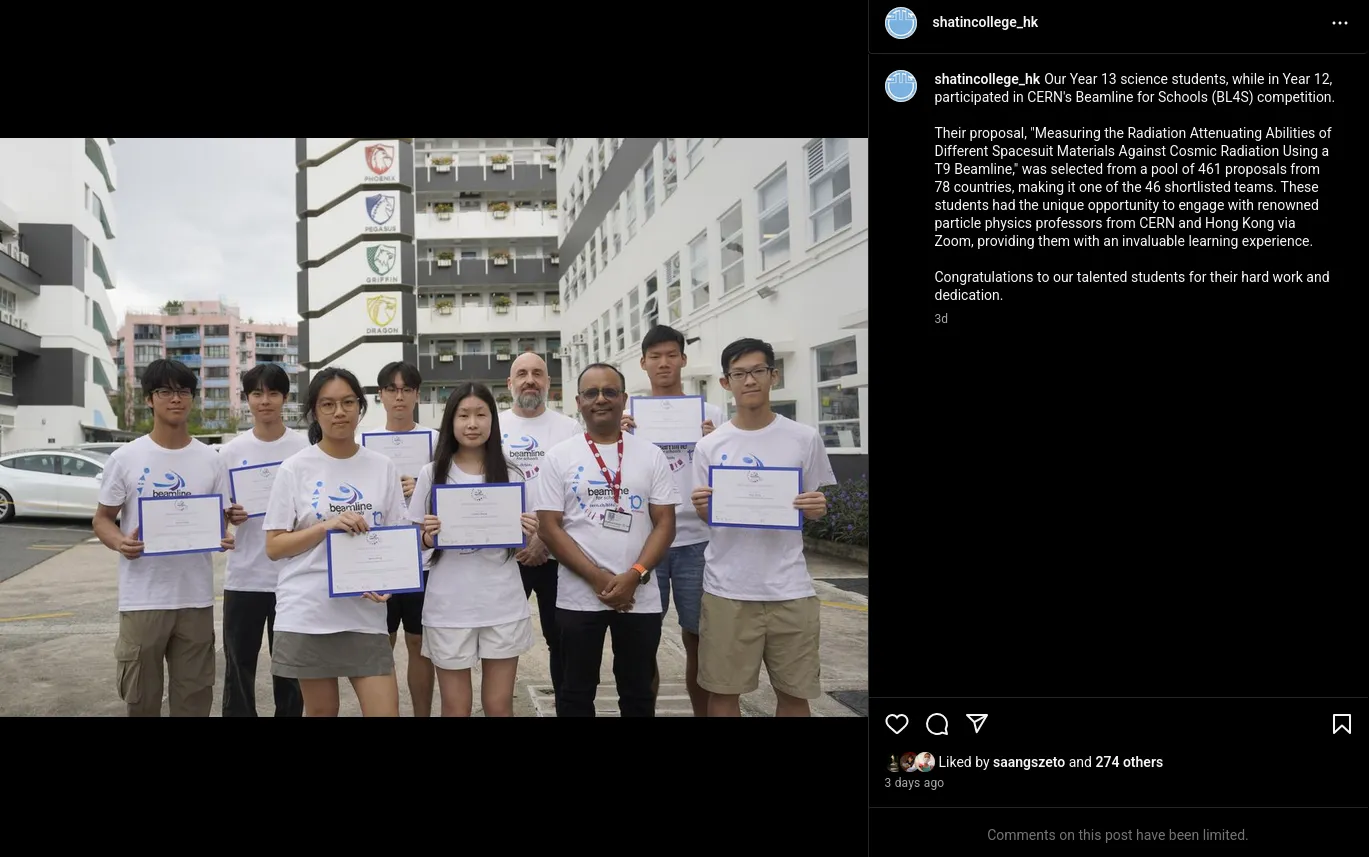This year, I joined CERN’s Beamline for Schools (BL4S) competition together with a team of eight other students. In this competition, participants from high-schools around the world submit high-energy physics research proposals making use of a “beamline” (a component of a particle accelerator).
Our team, Lepton Leapers, submitted a proposal for testing the ability of spacesuits to shield astronauts from cosmic radiation. More specifically, we proposed to test a variety of materials arranged in different configurations by firing particle beams at the suit material and detecting how much of the radiation passed through.
Spacesuit configurations
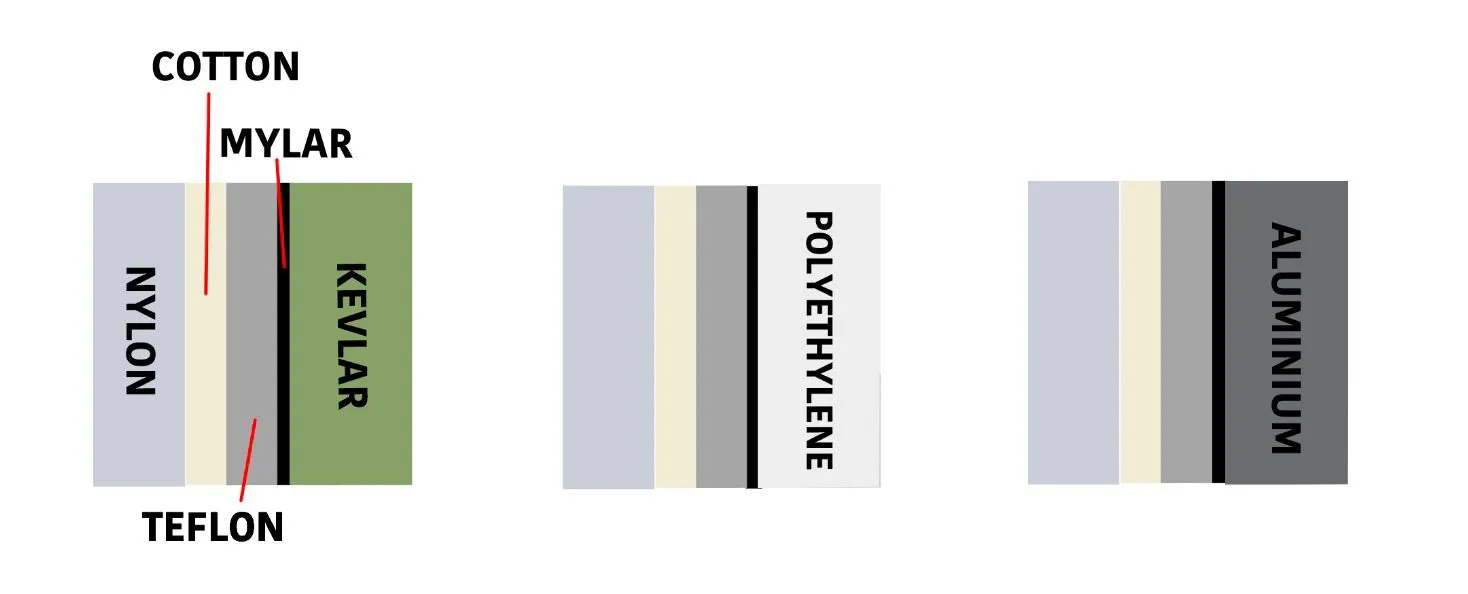
Solid configurations
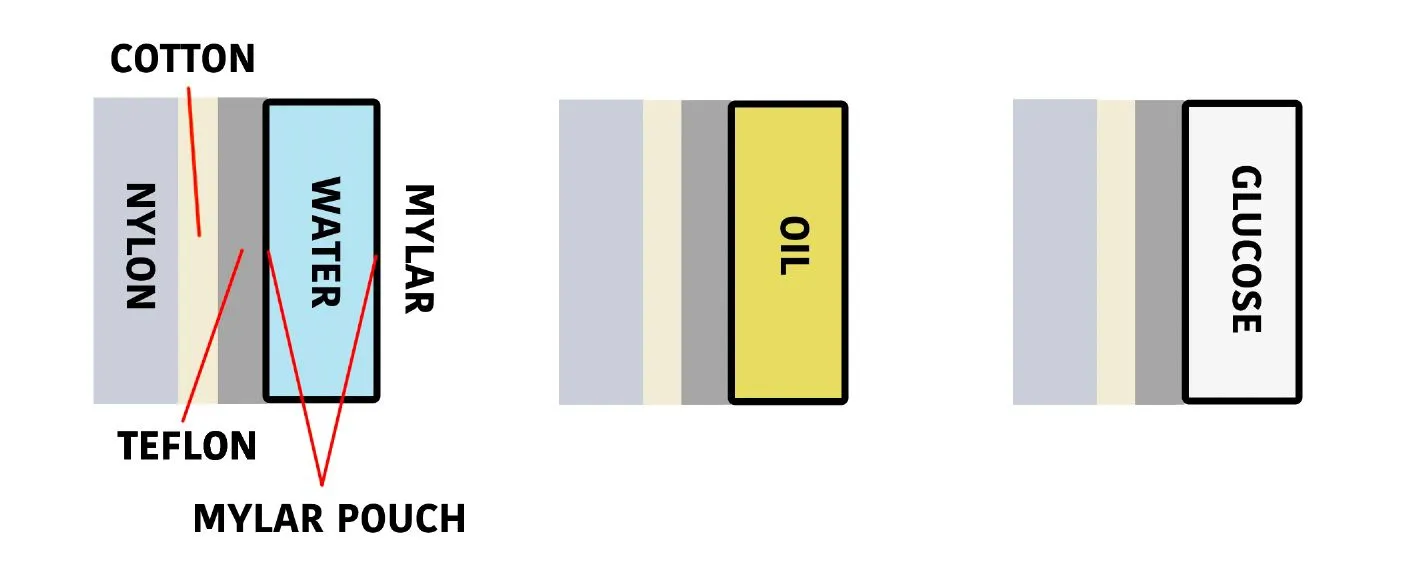
Fluid configurations
In total, we tested 6 different configurations, 3 of which used solid materials and 3 of them used fluids enclosed in a Mylar pouch.
Particle simulations
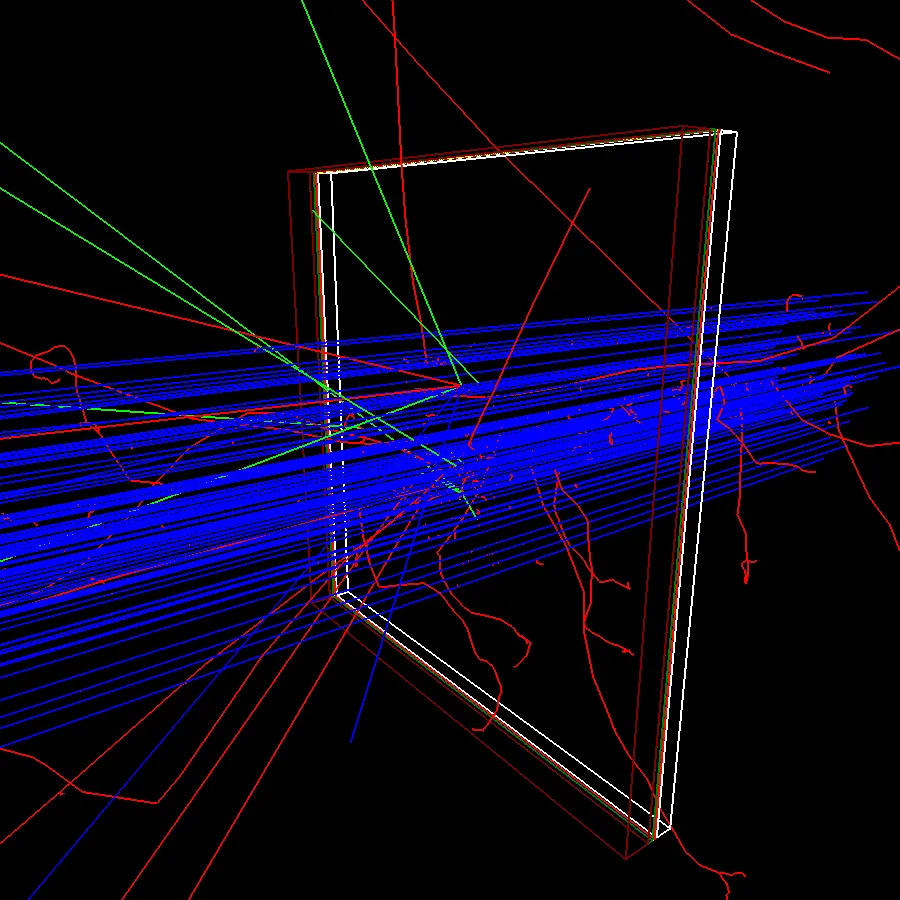
Solid configuration simulation
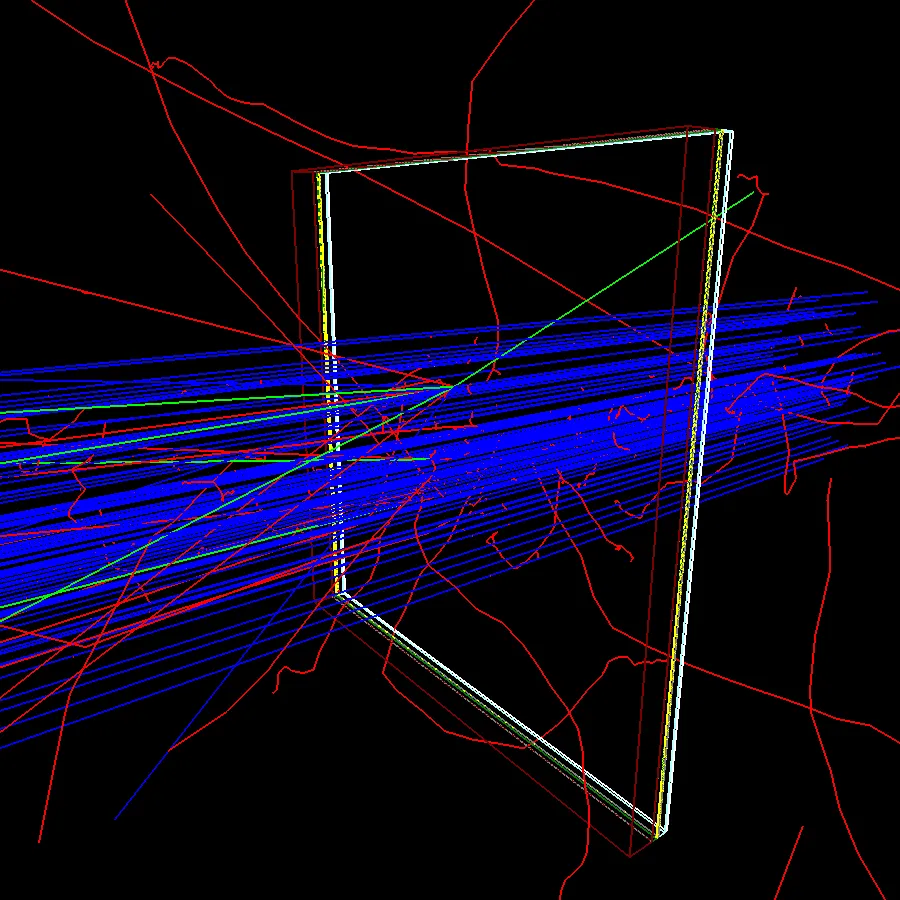
Fluid configuration simulation
My primary role within the team was to create simulations for our spacesuit configurations to obtain preliminary results for the experiment before conducting it on the real beamline.
I used TOPAS, a simulation tool based on CERN’s Geant4 Monte Carlo simulator. Simulations were configured in TOPAS’ configuration file syntax, like the following file for solid spacesuit simulations:
i:Ts/NumberOfThreads = 16
b:Ge/World/Invisible = "True"
sv:Ma/Cotton/Components = 3 "Carbon" "Hydrogen" "Oxygen"
uv:Ma/Cotton/Fractions = 3 6 10 5
b:Ma/Cotton/NormalizeFractions = "True"
d:Ma/Cotton/Density = 1.55 g/cm3
d:Spacesuit/HLX = 100 mm
d:Spacesuit/HLY = 100 mm
s:Ge/Outer/Material = "G4_KEVLAR" # (1)
# s:Ge/Outer/Material = "G4_POLYETHYLENE" # (2)
# s:Ge/Outer/Material = "Aluminum" # (3)
s:Ge/Outer/Parent = "World"
s:Ge/Outer/Type = "TsBox"
d:Ge/Outer/HLZ = 3.175 mm
d:Ge/Outer/HLX = Spacesuit/HLX mm
d:Ge/Outer/HLY = Spacesuit/HLY mm
d:Ge/Outer/TransZ = 0 mm
s:Ge/Outer/Color = "white"
s:Ge/Middle/Material = "Mylar"
s:Ge/Middle/Parent = "World"
s:Ge/Middle/Type = "TsBox"
d:Ge/Middle/HLZ = 0.5 mm
d:Ge/Middle/HLX = Spacesuit/HLX mm
d:Ge/Middle/HLY = Spacesuit/HLY mm
d:Ge/Middle/TransZ = 3.675 mm
s:Ge/Middle/Color = "red"
s:Ge/Inner1/Material = "G4_TEFLON"
s:Ge/Inner1/Parent = "World"
s:Ge/Inner1/Type = "TsBox"
d:Ge/Inner1/HLZ = 0.5 mm
d:Ge/Inner1/HLX = Spacesuit/HLX mm
d:Ge/Inner1/HLY = Spacesuit/HLY mm
d:Ge/Inner1/TransZ = 4.675 mm
s:Ge/Inner1/Color = "yellow"
s:Ge/Inner2/Material = "Cotton"
s:Ge/Inner2/Parent = "World"
s:Ge/Inner2/Type = "TsBox"
d:Ge/Inner2/HLZ = 1 mm
d:Ge/Inner2/HLX = Spacesuit/HLX mm
d:Ge/Inner2/HLY = Spacesuit/HLY mm
d:Ge/Inner2/TransZ = 6.175 mm
s:Ge/Inner2/Color = "green"
s:Ge/Bottom/Material = "G4_NYLON-8062"
s:Ge/Bottom/Parent = "World"
s:Ge/Bottom/Type = "TsBox"
d:Ge/Bottom/HLZ = 0.005 mm
d:Ge/Bottom/HLX = Spacesuit/HLX mm
d:Ge/Bottom/HLY = Spacesuit/HLY mm
d:Ge/Bottom/TransZ = 7.18 mm
s:Ge/Bottom/Color = "blue"
s:Ge/BeamPosition/Parent = "World"
s:Ge/BeamPosition/Type = "Group"
d:Ge/BeamPosition/TransX = 0 m
d:Ge/BeamPosition/TransY = 0 m
d:Ge/BeamPosition/TransZ = Ge/World/HLZ m * -1
d:Ge/BeamPosition/RotX = 0 deg
d:Ge/BeamPosition/RotY = 0 deg
d:Ge/BeamPosition/RotZ = 0 deg
s:So/Beam/Type = "Beam"
s:So/Beam/Component = "BeamPosition"
s:So/Beam/BeamParticle = "proton"
d:So/Beam/BeamEnergy = 15 GeV
u:So/Beam/BeamEnergySpread = 0.757504
s:So/Beam/BeamPositionDistribution = "Gaussian"
s:So/Beam/BeamPositionCutoffShape = "Ellipse"
d:So/Beam/BeamPositionCutoffX = 10 cm
d:So/Beam/BeamPositionCutoffY = 10 cm
d:So/Beam/BeamPositionSpreadX = 0.65 cm
d:So/Beam/BeamPositionSpreadY = 0.65 cm
s:So/Beam/BeamAngularDistribution = "Gaussian"
d:So/Beam/BeamAngularCutoffX = 90 deg
d:So/Beam/BeamAngularCutoffY = 90 deg
d:So/Beam/BeamAngularSpreadX = 0.0032 rad
d:So/Beam/BeamAngularSpreadY = 0.0032 rad
i:So/Beam/NumberOfHistoriesInRun = 1000
s:Ge/Surface/Material = "G4_SKIN_ICRP"
s:Ge/Surface/Parent = "World"
s:Ge/Surface/Type = "TsBox"
d:Ge/Surface/HLZ = 5 mm
d:Ge/Surface/HLX = Spacesuit/HLX mm
d:Ge/Surface/HLY = Spacesuit/HLY mm
d:Ge/Surface/TransZ = 12.185 mm
s:Ge/Surface/Color = "maroon"
s:Sc/PhaseSpace/Quantity = "PhaseSpace"
b:Sc/PhaseSpace/OutputToConsole = "True"
s:Sc/PhaseSpace/Surface = "Surface/ZMinusSurface"
s:Sc/PhaseSpace/OutputType = "ASCII"
s:Sc/PhaseSpace/OutputFile = "spacesuit"
i:Sc/PhaseSpace/OutputBufferSize = 1000
b:Sc/PhaseSpace/IncludeRunID = "True"
b:Sc/PhaseSpace/IncludeEventID = "True"
b:Sc/PhaseSpace/IncludeTrackID = "True"
b:Sc/PhaseSpace/IncludeTime = "True"
b:Sc/PhaseSpace/IncludeSeed = "True"
s:Sc/PhaseSpace/IfOutputFileAlreadyExists = "Overwrite"
b:Sc/PhaseSpace/OutputAfterRun = "True"
# s:Gr/View/Type = "OpenGL"
# i:Gr/View/WindowSizeX = 900
# i:Gr/View/WindowSizeY = 900
# d:Gr/View/Theta = 55 deg
# d:Gr/View/Phi = 20 deg
# s:Gr/View/Projection = "Perspective"
# d:Gr/View/PerspectiveAngle = 30 deg
# b:Gr/View/HiddenLineRemovalForTrajectories = "True"
# b:Ts/PauseBeforeQuit = "True"This declarative configuration syntax automatically configured Geant4, allowing me to choose and position materials, configure the particle beam and “scoring” (particle detector) and create a visualization.
Getting shortlisted & next steps
Our team was eventually shortlisted as one of the top 50 teams among the 461 entries worldwide.
Reflecting critically on our project, we believed that particle simulations and writing the academic report in LaTeX allowed us to stand out among other teams, as well as a good application of particle physics to engineering. Next time, we will focus more on developing the rigorous physics behind the interaction between cosmic radiation and spacesuit materials.
After representing Sha Tin College at BL4S, we are now going to advise the next team of Year 12s to join the competition, building on our experiences and lessons learnt. We hope that we can continue to develop our idea in our studies at university and beyond.
